Best Acne Scars Treatment: Advanced Techniques for Easier Skin
Best Acne Scars Treatment: Advanced Techniques for Easier Skin
Blog Article
Discovering Skin Disease: Dealing With and determining Acne Scars for Healthier Skin
Acne marks stand for a substantial worry for individuals seeking to maintain healthy skin, as they can influence both appearance and self-confidence. Understanding the different types of marks, from atrophic to hypertrophic, is crucial for figuring out proper therapy choices.
Comprehending Acne Marks

The body's all-natural healing process can result in either atrophic scars, which look like clinical depressions in the skin, or hypertrophic scars, which are raised and result from overflow of collagen. Additionally, the mental toll of acne marks need to not be undervalued; many people report sensations of shame, stress and anxiety, and reduced self-worth. This psychological problem can influence social communications and overall lifestyle.
Addressing acne scars calls for a detailed understanding of their development and influence. Recognition of the capacity for long-lasting effects related to without treatment scars can motivate individuals to seek proper treatments. Early treatment and effective monitoring approaches can considerably enhance skin appearance and enhance mental durability, highlighting the significance of recognizing the intricacies bordering acne marks.
Sorts Of Acne Marks
Acne marks can be categorized into unique kinds, each displaying one-of-a-kind characteristics and needing details treatment techniques. skin rejuvenation treatments. The key kinds of acne scars consist of atrophic, hypertrophic, and keloid marks

Hypertrophic marks, on the other hand, are increased above the skin level and are the result of excessive collagen manufacturing during the recovery process. They commonly stay within the limits of the initial acne lesion. Keloid scars are similar but prolong beyond the original injury website, forming larger, elevated areas that can be itchy or excruciating.
Understanding these kinds of marks is crucial for selecting appropriate treatment alternatives. Various marks may react better to particular treatments, such as laser therapies, fillers, or medical treatments, emphasizing the value of a tailored method to acne scar management.
Identifying Your Marks
When reviewing the appearance of your skin, it is vital to accurately determine the sort of marks present, as this will certainly inform one of the most efficient therapy strategy. Acne scars normally fall under two categories: hypertrophic and atrophic marks. Atrophic marks, which are one of the most typical, look like clinical depressions or indentations on the skin. These can further be categorized into ice-pick marks, boxcar scars, and rolling marks, each displaying distinct qualities and requiring different approaches for assessment.
Hypertrophic scars, on the various other hand, are elevated and happen as a result of too much collagen manufacturing during the recovery process. Acknowledging the details functions of your marks-- such as width, depth, and structure-- is crucial for proper recognition (skin rejuvenation treatments). In addition, take into consideration the circulation of scars throughout your skin, as this can suggest see this the severity and period of the acne problem
Involving with a dermatologist can give useful insights right into the nature of your marks, aiding in the differentiation between various types. A thorough understanding of your marks will inevitably result in a more customized and effective treatment plan, making sure a clearer and healthier skin tone.
Treatment Options Readily Available
Identifying the particular sort of acne scars present on your skin prepares for checking out efficient therapy choices. Usual types of acne marks consist of atrophic (clinically depressed), hypertrophic (increased), and post-inflammatory erythema.
For atrophic marks, options such as chemical peels, microneedling, and laser resurfacing are commonly used. Chemical peels off make see use of acids to remove the outer layer of skin, promoting new cell growth. Microneedling entails tiny needles that produce micro-injuries, stimulating collagen manufacturing. Laser resurfacing targets harmed skin cells, boosting structure and tone.
Hypertrophic scars can be treated with corticosteroid injections to squash the mark or laser treatment to reduce redness and boost appearance. Silicone gel sheets and stress dressings might likewise aid in taking care of increased marks.
On top of that, dermal fillers can briefly load in anxieties from atrophic marks, while surgical excision might be ideal for serious cases. Each treatment alternative has its benefits and factors to consider, making it necessary to talk to a dermatologist. They can offer customized suggestions based on the kind and severity of your scars, in addition to your skin type and overall health and wellness.
Tips for Avoidance
Effective avoidance methods can considerably minimize the probability of developing acne marks. The very first step is to maintain a constant skincare routine that includes gentle cleaning, exfoliation, and moisturizing. Using non-comedogenic items helps prevent clogged pores, which can aggravate acne. Furthermore, incorporating topical therapies consisting of salicylic acid or benzoyl peroxide can properly minimize and manage outbreaks swelling.
Preventing need to pick or pop find this acne sores is critical, as this can cause much deeper skin damages and raise the risk of scarring. Rather, take into consideration making use of a cool compress or over the counter treatments to lower swelling and redness.
Sunlight security is one more important element of avoidance; ultraviolet (UV) rays can darken scars and hinder the recovery process. Using a broad-spectrum sunscreen with at the very least SPF 30 daily can protect the skin and promote also healing.
Finally, preserving a balanced diet plan rich in minerals, anti-oxidants, and vitamins sustains skin health and recovery. Staying hydrated and taking care of tension levels can likewise play a considerable role in reducing acne flare-ups. By implementing these methods, individuals can significantly reduce their opportunities of developing acne marks.
Verdict
In final thought, understanding and recognizing acne marks is necessary for efficient treatment and accomplishing healthier skin. Various sorts of acne scars, consisting of atrophic and hypertrophic marks, require particular interventions tailored to individual requirements. Treatment options range from chemical peels and microneedling to corticosteroid shots, highlighting the importance of getting in touch with a dermatologist. Additionally, adopting a mild skincare regimen and securing the skin from UV exposure can substantially contribute to the prevention of further scarring and general skin health and wellness.
The body's natural recovery process can result in either atrophic scars, which appear as clinical depressions in the skin, or hypertrophic marks, which are elevated and result from overproduction of collagen. They are more separated right into 3 subtypes: ice choice marks, boxcar marks, and rolling scars. Acne scars usually drop right into 2 categories: atrophic and hypertrophic scars. These can further be identified into ice-pick marks, boxcar marks, and rolling scars, each displaying unique attributes and requiring various approaches for evaluation.
Various types of acne scars, consisting of hypertrophic and atrophic scars, demand specific interventions tailored to private needs.
Report this page